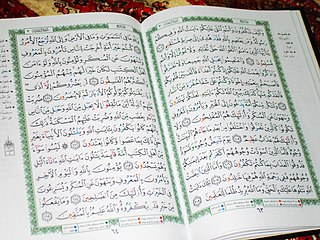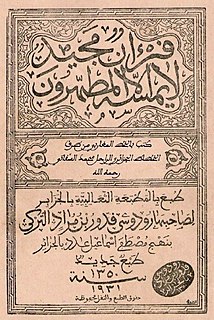| Author | Allah |
|---|---|
| Original title | مصحف عثمان طه |
| Language | Arabic |
| Series | Warsh recitation |
| Genre | Quranic Mus'haf |
Publication date | 2013 |
| Pages | 573 |
The Uthman Taha Quran is a Mus'haf written with the Kufic script by the calligrapher Uthman Taha according to Warsh recitation and other recitations. [1] [2]
The transcription of this Mus'haf was done in accordance with the Warsh recitation which is the main canonical Quranic recitation (Qira'a) or method of reciting the Qur'an practiced in North Africa. [3] [4]
This Mus'haf was written by calligrapher Uthman Taha (born 1934) according to the way of Al-Azraq (1208 – 1276 CE). [5] [6]
This manuscript has been produced on 573 pages, each of them containing 15 lines of verses from the Quran. [7] [8]
The owners of Al-Dar Al-Shamiya (Arabic : الدار الشامية) in Syria owned the rights to print the first copy of the Quran that Uthman Taha wrote for them in 1970. [9]
This Mus'haf was again printed in Medina for the first time, after minor repairs to the first edition of Al-Dar Al-Shamiyya, by the Quran Review Committee, which took permission to reprint from the original Syrian printing press.
Then, starting in the year 1415 AH, the African Mus'haf (Arabic : مصحف إفريقيا) printing press issued a Quran that spread across the African continent, and appeared in a luxurious and very beautiful garment in Uthman Taha's handwriting as a clone of the first copy of the Al-Dar Al-Shamiya in Syria. [10]
The State of Kuwait also issued the Kuwait Quran, based on the edition of the African Mus'haf, in a beautiful luxurious edition, and by making some slight modifications to some of the control marks. [11]

A muṣḥaf is an Arabic word for a codex or collection of sheets, but also refers to a written copy of the Quran. The chapters of the Quran, which Muslims believe was revealed during a 23-year period in Muhammad's lifetime, were written on various pieces of paper during Muhammad's era. Two decades later, these papers were assembled into one volume under the third caliph, Uthman ibn Affan, and this collection has formed the basis of all written copies of the Quran to the present day.

In Islam, Qirāʼah, which are "different linguistic, lexical, phonetic, morphological and syntactical forms permitted with reciting" the holy book of Islam, the Quran. Differences between Qiraʼat are slight and include varying rules regarding the "prolongation, intonation, and pronunciation of words", but also differences in stops, vowels, consonants, and less frequently entire words. Qiraʼat also refers to the "branch of Islamic studies" that deals with these modes of recitation.
The Tilawa is a recitation of the successive verses of the Quran in a standardized and proven manner according to the rules of the ten recitations.

Uthman ibn Abduh ibn Husayn ibn Taha Alkurdi is a Syrian calligrapher of the Quran in the Arabic language renowned for hand-writing Mushaf al-Madinah issued by the King Fahd Complex for the Printing of the Holy Qur'an.

King Fahd Complex for the Printing of the Holy Qur'an is a printing plant located in Medina, Saudi Arabia that publishes the Qur'an in Arabic and other languages.
Riad Taha,, was a Shia Lebanese journalist and president of the Lebanese Publishers Association. He was assassinated when gunmen opened fire on his car. Perpetrators were never caught, but it was widely suspected that the assassination was ordered by the Syrian Intelligence. He was the head of the Lebanese Publishers Association from 1967 until his murder.
Abū ʽAmr Ḥafṣ ibn Sulaymān ibn al-Mughīrah ibn Abi Dawud al-Asadī al-Kūfī, better known as Hafs, is a significant figure in the art of Qur'an reading and variant recitations (qira'at). Being one of the primary transmitters of one of the seven canonical methods of Qur'an recitation, his method via his teacher Aasim ibn Abi al-Najud has become the most popular method across the majority of the Muslim world.

Abu Sa'id Uthman Ibn Sa‘id al-Qutbi, better known as Warsh (110-197AH), was a significant figure in the history of Quranic recitation (qira'at), the canonical methods of reciting the Qur'an. Alongside Qalun, he is one of the two primary transmitters of the canonical reading method of Nafi‘ al-Madani. Together, their style is the most common form of Qur'anic recitation in the generality of African mosques outside of Egypt, and is also popular in Yemen and Darfur despite the rest of Sudan following the method of Hafs. The method of Warsh and his counterpart Qalun was also the most popular method of recitation in Islamic Spain. The majority of printed Mushafs today in North Africa and West Africa follow the reading of Warsh.
The Algeria Quran is a Quranic manuscript (mus'haf) written in Algeria with the Kufic script, written according to the Warsh recitation in 1977 by Mohamed Cherifi.

The Thaalibia Quran is a Quranic manuscript (mus'haf) written in Algeria with the Maghrebi script.
Thaalibia Publishing is an Algerian publishing house based in Algiers and founded in 1895. It publishes books in religion, Sufism, literature, nationalist thought, and art as well as culture. Thaalibia Publishing had a wide distribution network within Algeria and North Africa.
The Zawiyas in Algeria are religious buildings located in Algeria honoring the memory of patron saints and dedicated to Quranic and religious education. They are affiliated with Sufi Torouq brotherhoods under the supervision of the Ministry of Religious Affairs and Endowments in accordance with the precepts of the Algerian islamic reference.
The Salka is a collective recitation of all sixty hizbs of Quran done by murids and saliks in islamic sufism.
The Warsh recitation or Warsh ʽan Naafiʽ' is a Qira'at of the Quran in Islam.
The Hezzab is the hafiz or qāriʾ supervising or participating in the Hizb Rateb in mosques and zawiyas in Algeria according to the Algerian Islamic reference under the supervision of the Ministry of Religious Affairs and Endowments.
The Idjaza is a certification from the Sheikh for the legal Talibe that he had recited the entire Quran from him by heart with intonation, mastery and differentiation between similarities, and became qualified for recitation. Some Qāriʾs are lenient in memorizing, so they do not require memorization by qalb.
The ten recitations or ten readings are ten Qira'ates and recitations of the Quran approved by scholars in their research to determine the frequent recitations.
The Seven readers are seven Qāriʾs who mastered the Qira'at and historically transmitted the Quran recitations in an approved and confirmed manner.
The Prostration of recitation is a prostration (sujud) which occurs during the ritual Tilawa of Quran in Salah or outside it.
Abu Bakr al-Isfahani, popularly known as Al-Isfahani, was a Persian Qari specialized in Warsh recitation.